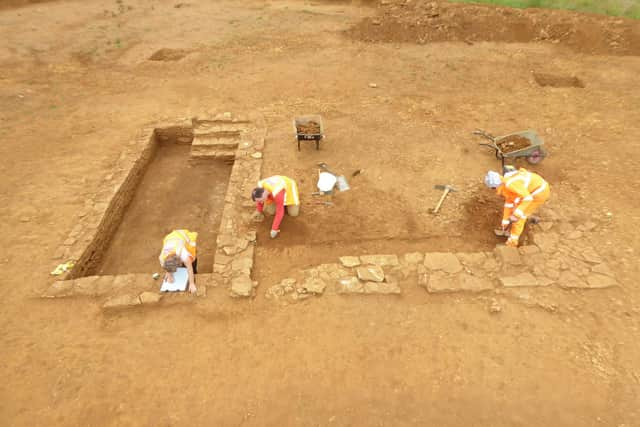‘Fascinating’ and ‘highly significant’ 4,000-year-old centre of ritual activity discovered at Northamptonshire housing development
and live on Freeview channel 276
Remains from a 4,000-year-old area of ritual activity have been discovered at the site of a new housing development in Northamptonshire.
In Overstone, as part of a Taylor Wimpey and Vistry Group housing development - The Atrium, archeologists have found a Bronze Age barrow and a Roman building once decorated with elaborate plasterwork, which has been interpreted as a shrine.
Advertisement
Hide AdAdvertisement
Hide AdThe site also contained large Roman water tanks, at the bottom of which were 2,000-year-old remains of tree blossoms, walnut shells and even a leather shoe.


These archaeological excavations have uncovered an ancient focal point of ritual and religious activity centred around a natural spring and have been revealed by archaeologists from MOLA (Museum of London Archaeology), who excavated on behalf of the housebuilders.
MOLA project manager Simon Markus said: “The fact no human remains were placed within the barrow suggests it may have had a more symbolic rather than functional use.
“It seems very likely this landscape was already a highly significant place for local ancient communities, and those pre-existing associations led people in the Bronze Age to pick this site for the construction of a ritual monument.”
Advertisement
Hide AdAdvertisement
Hide AdAccording to archeologists, during the Roman period (43 AD – 410 AD) the site gained new significance and an unusual stone building was constructed. Decorated with elaborately painted plasterwork, possibly a painted ceiling, and containing an underground room, it appears to have had no functional use.
Consequently, this has been interpreted by archaeologists as a shrine, likely associated with the nearby spring. Visitors may have left votive offerings, including coins and other artefacts, although none were found during the excavations.
Archeologists also add that the spring was not just the focus of worship during the Roman period. The discovery of large water tanks indicate the spring water was used for processing crops and other industrial activities. It also provided valuable drinking water and the water remains drinkable to this day.
Victor Idowu land and planning director at Taylor Wimpey South Midlands added: “It has been fascinating to learn what the team has uncovered at the site. The findings here are not only important within an archaeological context, but they will now also influence the placemaking of the site.
Advertisement
Hide AdAdvertisement
Hide Ad“As part of the works we will be maintaining the water courses, building upon the ancient significance and symbolism of Overstone.”
Archaeologists are continuing to study and analyse finds from the site, with their focus now turning to the environmental remains, preserved for thousands of years by the sacred spring. Through this analysis they will build a fuller picture of how this important site was connected to the surrounding landscape.
Once complete, there will be a total of 350 homes on site at The Atrium, which will include 93 'affordable' properties. The housebuilder says it will be complete by 2025.
The Atrium is part of wider ‘sustainable urban extension’ including a total of 2,000 homes in Overstone, hundreds of which have already been built as part of the Overstone Leys development.
